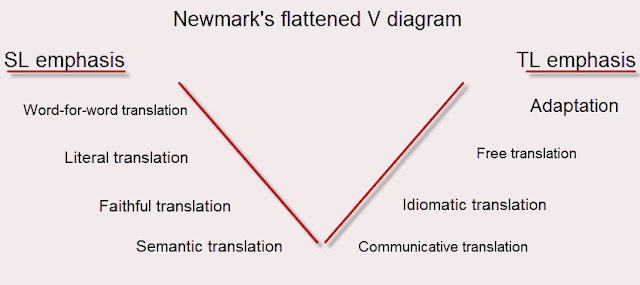Word-for-word Translation
The TL translation is immediately below the SL words. The word order is preserved and the words are translated individually by their most common meaning out of context. Cultural words are translated literally. The main use of this method is either to understand the mechanics of the source language or to use it as a pre-translation process.
Literal Translation
The SL grammatical constructions are converted to their nearest TL equivalents but the lexical words are translated individually with their meaning out of context.
Faithful Translation
It attempts to reproduce the precise contextual meaning of the original within the constraints of the TL grammatical structures, as well as to be completely faithful to the intentions and the text-realization of the SL writer.
Semantic Translation
Semantic translation reaches as much accuracy as faithful translation, though semantic translation takes more account of the aesthetic value of the SL, compromising on (giving up) meaning where appropriate so that word-play or repetition can be preserved. Consequently, semantic translation is flexible and admits some creatively from the translator.
Adaptation
It is the "freest" form of translation which is used mainly for plays and poetry. Once a play or poem is literally translated, it is rewritten by an established dramatist or poet. Even though three has bee many poor adaptations, there has been some cases where period plays has been rescued.
Free Translation
It reproduces the content without the form. It is usually a paraphrase much longer than the original.
Idiomatic Translation
Idiomatic translation reproduces the message of the original but tends to distort nuances of meaning by preferring collocations and idioms where these do not exist in the original.
Communicative Translation
It attempts to render the exact contextual meaning in such a way that both content and language are acceptable and comprehensible to the readership.
Translation Procedures
While translation methods relate to whole texts, translation procedures are used for sentences an the smaller units of language. These procedures always depend on the contextual factors. However, literal translation, which is the most important procedure, does not depend on contextual elements.
> Transference
Transference is the process of transferring a SL word to a TL text as a translation procedure. The word to be transferred should be a SL cultural word, that once transferred, becomes a "loan word". The names of SL objects, inventions, devices, processes to be imported into the TL community should be creatively translated. At the same time, one cannot be rigid, because the media as the experts will be transferring words whether the translator likes it or not. The following elements are normally transferred: names of all living and most dead people; newly independent countries, unless they have recognized translations; names of newspapers, titles of as yet untranslated literary works, plays, movies, names of private companies and institutions.
> Naturalization
It adopts a SL word first to the normal pronunciation, then to the normal morphology of the TL.
> Cultural Equivalent
This is an approximate translation in which a SL word is translated into a roughly equivalent TL cultural word. Their translation uses are limited because they are not accurate.
> Functional Equivalent
This procedure requires the use of a cultural word which is translated into a new specific term. Thus, there is either a neutralization or generalization of the SL word, and sometimes an introduction of a particular new meaning.
> Descriptive Equivalent
It is the translation of a SL word into a description of what it refers to in the TL.
> Synonymy
It is the use of a near TL equivalent to a SL word in a context where a precise equivalent may not exist. Particularly, adjectives and adverbs are object to this procedure since it many cases they do not play an important part in the text.
> Reduction and Expansion
It is essentially the removing or adding of elements in the TL text. Naturally, the expansion takes place within the text, but it also includes notes at the bottom of the page, end of chapter or book.
> Paraphrase
It is an amplification or explanation of a segment of a word.
> Compensation
This occurs when a loss of meaning, sound-effect, metaphor in one part of a sentence is compensated in another part.
> Transposition
Since two languages do not have the same grammatical structure, some changes in, for example, word order, a part of speech or construction have to be done. The most common type of shifts of translation are:
- Two grammatical structures exist in both languages, but they work different.
- Order of adjectives
- Change from singular to plural or vice versa
- A SL grammatical structure does not exist in the TL.
- Spanish neutral adjectives
- English gerund
- Auxiliary "do" in English, as in I did go
- The structure: adjective + for (pronoun) + inf
- Although a SL grammatical structure is possible in the TL, a change would be better
- A change in verb tense or mood
- Necessary insertions in translations that are too concise and therefore unnatural.
- Prepositions
- Demonstrative pronouns
- Conjunction
- When omissions are necessary
- The reinforcement of an idea which is redundant in the other language
- Can + a verb of perception
- Using + noun + inf
- Prepositions in idiomatic expressions
- Subjects
- There + verb (other than to be)

No comments:
Post a Comment